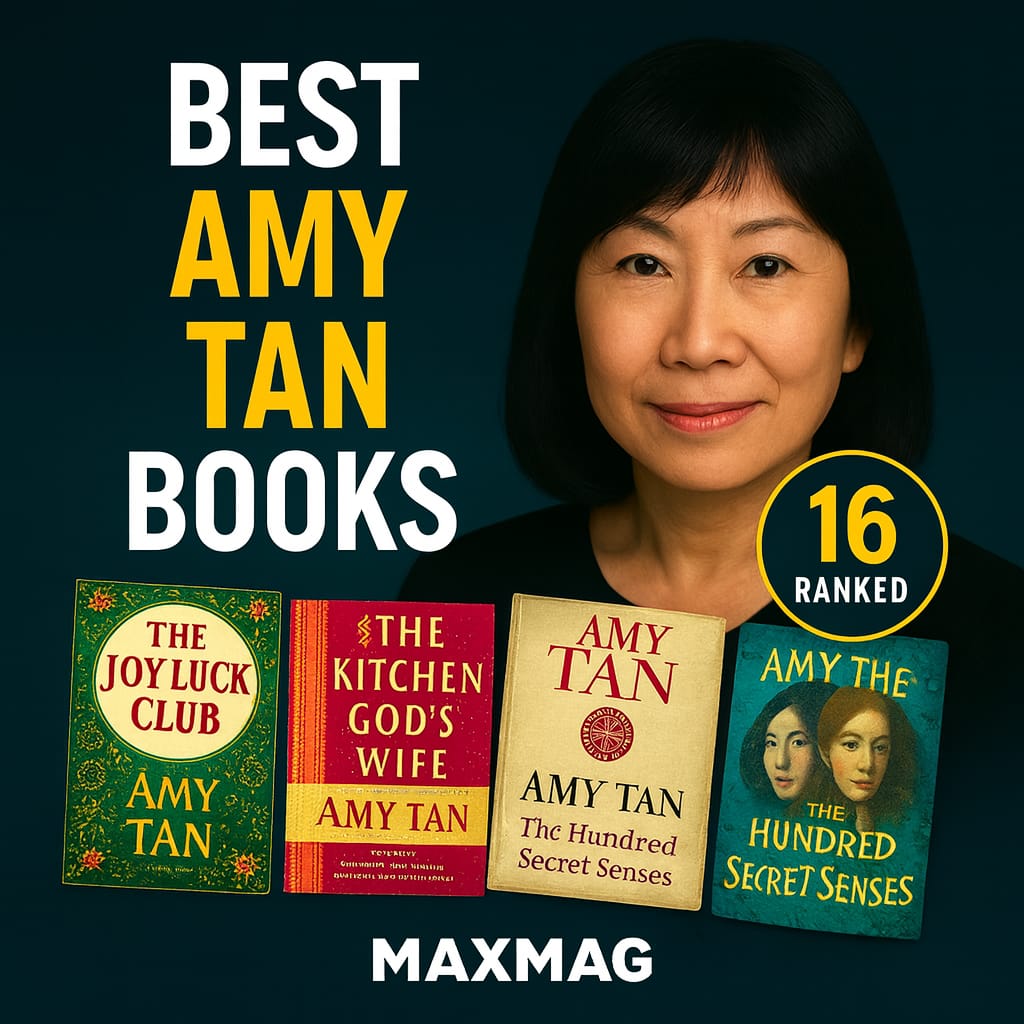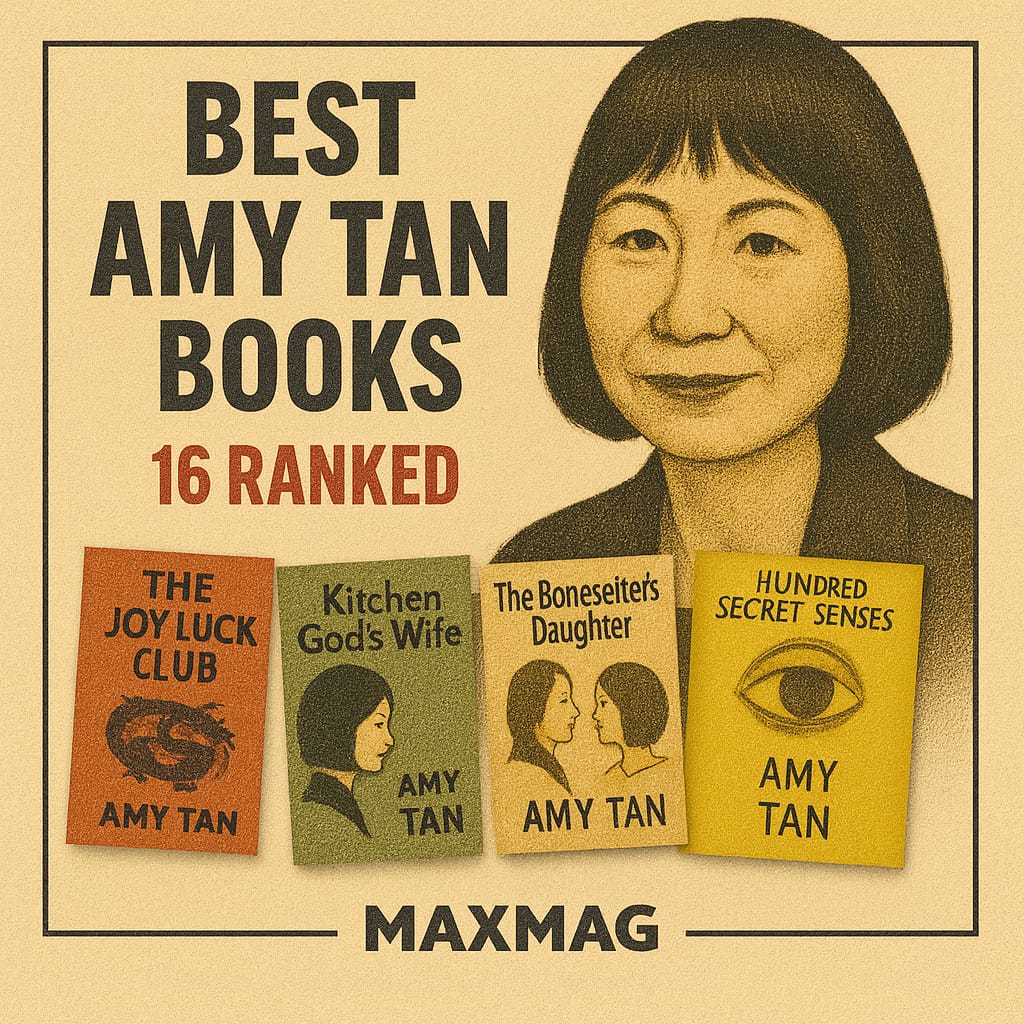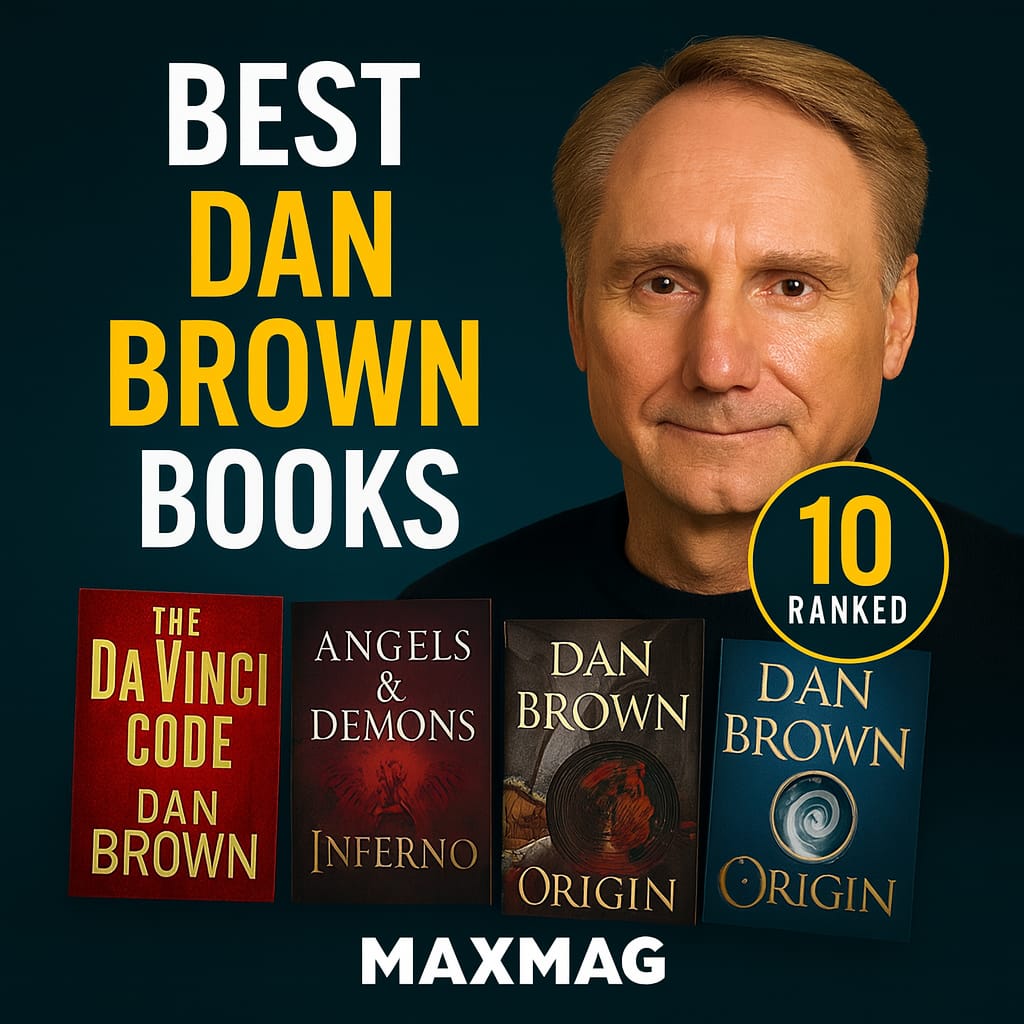
Across American letters, a clear throughline runs to the Best Amy Tan Books that examine mothers and daughters across languages and time. Amy Ruth Tan was born in Oakland, California, and is widely associated with immigrant‑family fiction and cross‑cultural storytelling. She writes primarily novels, memoir, and children’s picture books. She is best known for The Joy Luck Club and The Bonesetter’s Daughter. Her career spans from 1989 into the 2020s, including a recent turn to nature journaling. Core biographical notes and principal works appear across standard references and bibliographies. This article surveys those sources to frame reporting on the Best Amy Tan Books.
Her breakout was The Joy Luck Club (1989), a best‑selling debut that braided intergenerational stories across two continents. Subsequent fiction and nonfiction track memory, translation, family secrets, and the afterlife of migration. Recurring subjects include mother‑daughter bonds, ghosted pasts, and the pull of China against life in the United States. Readers return for layered family plots and the way private histories surface in ordinary life. This guide covers 16 titles from 1989 to 2024. It is sequenced in rising rating order; ties by year, then title. Across these choices, the Best Amy Tan Books reflect both longstanding motifs and recent nonfiction turns.
16 Best Amy Tan Books in a Rising Rating Order
Methodology & Updates
Sources include Goodreads title pages and the author’s listings, captured October 21, 2025; positions follow average reader ratings (≥3.0) with ties resolved by earlier year, then A–Z. Occasional re‑ratings may shift positions over time, so figures here are a dated snapshot of the Best Amy Tan Books.
#1) Rules for Virgins – 2011
- Author: Amy Tan
- Published: 2011
- Work Type / Genre Tags: novella, historical fiction
- Themes: performance, desire, power
- Goodreads Rating: 3.44/5
In early 20th‑century Shanghai, a courtesan named Violet prepares for work in a tightly managed house. A madam outlines the precise rules that will govern Violet’s body, time, and income. Violet seeks a path to prestige while guarding her autonomy. Tensions develop between handlers, patrons, and rivals who watch for missteps. Contracts, gifts, and coded gestures complicate Violet’s ascent. A risky negotiation threads through her early appointments and sworn alliances. The plot moves toward a defining evening that will test her status and options. The final image fixes the cost attached to each favor and promise.
#2) Saving Fish from Drowning – 2005
- Author: Amy Tan
- Published: 2005
- Work Type / Genre Tags: novel, travel misadventure, satire
- Themes: misperception, authority, myth
- Goodreads Rating: 3.47/5
In San Francisco, socialite Bibi Chen dies before leading a Myanmar tour she curated. A dozen travelers continue, unaware the narration tracks them from Bibi’s posthumous vantage. The group wants a curated experience and light adventure. Local fixers, military presence, and a missing person escalate the itinerary into a pursuit. Checkpoints, guides, and river crossings widen the gap between what the group believes and what is happening. Folklore and rumor shape decisions as the travelers improvise. The climax lines up around a rescue attempt that depends on misread signs. The outcome leaves alliances altered and the route forever annotated.
#3) Where the Past Begins – 2017
- Author: Amy Tan
- Published: 2017
- Work Type / Genre Tags: memoir, creative process
- Themes: memory, family archives, making art
- Goodreads Rating: 3.58/5
The story opens with a private archive of letters, photos, and marginal notes. The narrator reconstructs family migrations and the losses that marked adolescence. She sets a working problem: how to translate family traces into narrative. Mother–daughter exchanges and immigrant histories form the throughline that explains choices. Studio routines, drafts, and false starts become episodes with their own tensions. A long‑running question about voice rises and recedes as the pages turn. The climax circles a decision about what to keep and what to leave unspoken. The book closes on the consequence of binding scattered fragments into a single record.
#4) Mid‑Life Confidential – 1994
- Author: Amy Tan
- Published: 1994
- Work Type / Genre Tags: road chronicle, anthology (co‑authored)
- Themes: performance, friendship, touring
- Goodreads Rating: 3.61/5
A band of writers, the Rock Bottom Remainders, takes a small bus across U.S. venues. Rehearsals, late shows, and green rooms form a repeating loop. Each stop sets up new minor conflicts over set lists, stamina, and nerves. The chapters rotate perspectives as the troupe navigates fans, family, and fatigue. Incidents onstage and offstage build a portrait of camaraderie under pressure. Travel delays and mishaps test the schedule and the pact to keep playing. The momentum points toward a final gig that stands in for the whole run. The last pages trace the afterglow and the residue of noise and motion.
#5) Two Kinds – 2000
- Author: Amy Tan
- Published: 2000
- Work Type / Genre Tags: short story, coming‑of‑age
- Themes: ambition, expectation, identity
- Goodreads Rating: 3.69/5
In San Francisco, a Chinese American girl and her mother argue over talent and success. A piano becomes the instrument of a parental plan. The girl wants ordinary freedoms while her mother insists on practice and performance. Rehearsals, lessons, and one public recital concentrate the fault lines. Family friends and neighbors serve as the audience that heightens the stakes. After the recital, the family recalibrates who decides what the girl will be. Years pass, and the story returns to a room and an instrument. The closing scene locates two melodies and the life between them.
#6) The Valley of Amazement – 2013
- Author: Amy Tan
- Published: 2013
- Work Type / Genre Tags: novel, historical family saga
- Themes: separation, reinvention, lineage
- Goodreads Rating: 3.70/5
In Shanghai at the turn of the 20th century, a mixed‑heritage girl grows up in a courtesan house. A sudden separation from her American mother triggers the central quest. She seeks to recover a lost link to family and past. Mentors and rivals within the courtesan world condition each move. Changing regimes and city geographies complicate escape and reunion plans. An old photograph and a set of garments direct the search. The arc builds toward a revelation that could reset identity and allegiance. The last chapter settles on what is found and what remains unclaimed.
#7) Hard Listening: The Greatest Rock Band Ever (of Authors) Tells All – 2013
- Author: Amy Tan
- Published: 2013
- Work Type / Genre Tags: multimedia chronicle, anthology (co‑authored)
- Themes: collaboration, fandom, behind‑the‑scenes
- Goodreads Rating: 3.88/5
Writers assemble set lists, trade emails, and rehearse under a novelty band’s banner. Tour dates produce vignettes about stages, small disasters, and near misses. The narrator’s segments track wardrobe, voice, and persona. Bandmates contribute scenes that frame the same nights from other angles. A charity event and a reunion show structure the momentum of the run. A planned encore threatens to unravel under fatigue and travel. The climax rests on a performance that holds because everyone stays in time. The final note marks what lingers when the house lights come up.
#8) The Best American Short Stories 1999 – 1999
- Author: Amy Tan
- Published: 1999
- Work Type / Genre Tags: edited anthology, contemporary short fiction
- Themes: selection, voice, American scenes
- Goodreads Rating: 3.92/5
An editor gathers new short stories from a year’s magazines. The opening pages set terms for what a story must do. Each selection introduces a different setting and premise. Sequencing places quiet pieces beside urgent ones to vary pace. Recurring motifs—family strain, work, law, chance—surface across disparate authors. Notes and attributions situate where and when each story first appeared. The order moves toward a closing run of longer, more intricate narratives. The collection ends by returning to the editor’s initial questions about form.
Early Currents: Best Amy Tan Books

#9) The Moon Lady – 1992
- Author: Amy Tan
- Published: 1992
- Work Type / Genre Tags: children’s picture book, folklore retelling
- Themes: wishes, memory, festival
- Goodreads Rating: 3.94/5
On a Mid‑Autumn night, a grandmother tells a tale from her girlhood. A child in 1930s China watches lanterns and boats light a river. She wishes for reunion as crowds and music swell. A parade and a stage performance separate her from family in the dark. Helpers and strangers show how a festival can both dazzle and disorient. A figure known as the Moon Lady becomes the focus of the search. The story steers toward a face‑to‑face moment that tests belief. The last page fixes the night as a memory that will be told again.
#10) The Opposite of Fate: Memories of a Writing Life – 2003
- Author: Amy Tan
- Published: 2003
- Work Type / Genre Tags: memoir, essays
- Themes: illness, family past, craft
- Goodreads Rating: 3.94/5
Childhood scenes establish a home shaped by loss and superstition. The narrator recounts migrations, schools, and a changing American landscape. She sets out to explain how certain stories began. Parents’ dictates, community expectations, and private fears become episodes. Illness and recovery interrupt and redirect a writer’s calendar. Travel and public readings add encounters that test the work’s meanings. The arc converges on how a page gets made from fragments and hunches. The closing note states what chance and choice finally allowed.
Later-Middle Turns: Best Amy Tan Books
#11) The Joy Luck Club – 1989
- Author: Amy Tan
- Published: 1989
- Work Type / Genre Tags: novel, linked family stories
- Themes: migration, language, mothers and daughters
- Goodreads Rating: 3.96/5
In postwar San Francisco, four Chinese immigrant mothers meet for mahjong. Their American‑born daughters grow up translating households and expectations. Each daughter presses for independence while decoding the past. Stories from wartime China and peacetime California braid into the present. Marriages, losses, and secrets surface in turns at the table. A journey back to China reframes what the daughters think they know. The narrative advances toward separate reconciliations that echo one another. The last scenes set the club’s meaning in a changed family map.
#12) The Hundred Secret Senses – 1995
- Author: Amy Tan
- Published: 1995
- Work Type / Genre Tags: novel, sister story
- Themes: loyalty, belief, inheritance
- Goodreads Rating: 4.00/5
In California, Olivia learns to live with her older half‑sister, Kwan. Kwan insists that ghosts and prior lives shape the present. Olivia wants proof while managing a marriage under stress. Letters and old photographs redirect the sisters to rural China. Guides, relatives, and rumors pull the trip off course. A local tale about a vanished couple becomes the key to several puzzles. The plot moves toward a choice about whom to trust when stories conflict. The ending holds on what the sisters accept as true.
#13) The Bonesetter’s Daughter – 2001
- Author: Amy Tan
- Published: 2001
- Work Type / Genre Tags: novel, multi‑generational mystery
- Themes: caretaking, translation, buried history
- Goodreads Rating: 4.00/5
In the Bay Area, Ruth cares for her mother, LuLing, as memory falters. A stack of pages in Chinese surfaces among family papers. Ruth seeks a translation that might steady their strained bond. Flashbacks track a girlhood in a village tied to an ink‑making clan. A namesake story, a promise, and a disappearance align in the background. Collaborators and experts test the limits of what can be recovered. The narrative rises toward an encounter with records and places thought lost. The final chapters state what must be remembered and what can be forgiven.
#14) The Backyard Bird Chronicles – 2024
- Author: Amy Tan
- Published: 2024
- Work Type / Genre Tags: illustrated nonfiction, field journal
- Themes: attention, place, observation
- Goodreads Rating: 4.02/5
At home and on nearby trails, the narrator keeps a seasonal log. Sketches and notes fix behavior, light, and song. She sets a steady routine of counting, drawing, and returning. Migratory cycles and weather shifts change what the pages show. Neighbors and friends enter as spotters who confirm sightings. A few rare appearances become mini‑quests with routes and times. The final stretch turns to habitat, feeders, and care for injured birds. The book closes on a year‑over‑year record that becomes its own map.
#15) The Kitchen God’s Wife – 1991
- Author: Amy Tan
- Published: 1991
- Work Type / Genre Tags: novel, mother’s life story
- Themes: survival, marriage, reinvention
- Goodreads Rating: 4.04/5
In San Francisco, Winnie Louie prepares to tell her daughter a long‑kept history. The account begins in prewar China with a young marriage and a household of rules. Winnie seeks safety as war, flight, and betrayal reconfigure her world. Friends and distant kin become lifelines and risks. Passage to America reframes earlier vows and debts. The present‑day confession presses toward a choice about truth and timing. A family banquet provides the moment to reveal what has been hidden. The narrative ends with a gesture that resets mother and daughter.
#16) Sagwa, The Chinese Siamese Cat – 1994
- Author: Amy Tan
- Published: 1994
- Work Type / Genre Tags: children’s picture book, origin tale
- Themes: mischief, justice, storytelling
- Goodreads Rating: 4.08/5
In a magistrate’s house, a pale kitten plays near scrolls and ink. A mishap with characters changes a posted rule. The kitten learns how a mark can affect a whole village. Family cats and household servants react as blame and credit shift. A parade of visitors spreads the story and its lesson. The magistrate faces a moment to reconsider his decree. The tale builds to a small act that becomes local legend. The last frame explains a coat’s markings and the nickname that endures.
The Crest: Best Amy Tan Books
Amy Tan: Life & Legacy
Amy Tan’s timeline runs from a 1950s California childhood to late‑career field notebooks, with novels, essays, and picture books along the way. Signature works include The Joy Luck Club, The Kitchen God’s Wife, The Hundred Secret Senses, The Bonesetter’s Daughter, and The Valley of Amazement. She has also published memoir and process reflections and guest‑edited an annual short‑story volume. Recognition includes the U.S. National Humanities Medal and other honors. Classroom and book‑club use embedded her family‑story architectures in contemporary syllabi. Her influence is visible in later fiction about diaspora and intergenerational memory. Within that landscape, the Best Amy Tan Books mark accessible entry points for new readers.
Conclusion
This report ranked 16 titles across three and a half decades, from early novels to recent nonfiction, revealing an arc from origin stories to layered returns. Taken at a glance, the ordering shows early experimentation, a long middle shaped by mother–daughter revelations, and late‑career range, including nature writing. For an overview of life and works, see the Encyclopaedia Britannica entry, which summarizes major books and periods.
Across the set, recurrent structures include braided timelines, confessions that alter family terms, and objects—letters, photos, garments—that trigger new journeys. Journalism and essays expand the frame to performance and process, while picture books adapt folklore to festival nights and household lore. For a recent journalistic angle on the author’s latest work, read the Associated Press review of The Backyard Bird Chronicles; it situates the project within broader interest in birdwatching and nature writing.
FAQ: What to know about the Best Amy Tan Books
Q1: Where should a new reader start with the Best Amy Tan Books?
Q2: Do the novels connect to one another?
Q3: Which nonfiction best explains her process?
Q4: Are children’s titles part of the same world?
Q5: How did you order this list?





